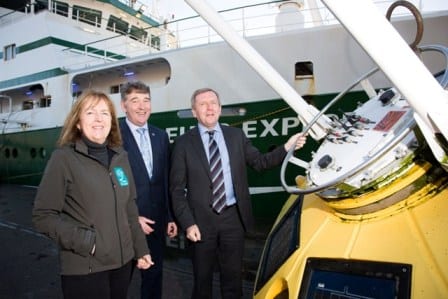
A significant expansion is in the works for the weather monitoring Marine Data Buoy Network in a year of storms.
Galway’s Marine Institute manages the Marine Data Buoy Network together with Met Éireann.
The buoy network provides crucial information for weather prediction, risk management for shipping, and gives advance warning to the fishing community and coastal towns and villages.
Minister for the Marine Michael Creed announced on Monday that €700,000 will be spent this year on existing operations and upgrading the network infrastructure.
Speaking from the deck of the RV Celtic Explorer Minister Creed said, “This increased expenditure will greatly assist our ocean and weather forecasting capabilities in the years ahead as well as supporting vital climate change research and improving safety at sea.”
The most westerly buoy in the network, M6, is called a sentinel buoy. From hundreds of kilometres off the west coast it gathers critical early information about weather approaching from the Atlantic.
Evelyn Cusack Head of Forecasting from Met Éireann who also attended the launch said, “The data buoys provide vital information about our weather such as atmospheric pressure, air and sea temperature, wind speed and direction.”
“This information is used in the weather forecasting models run by Met Éireann, that provide guidance to the national emergency planning efforts during extreme weather events including storms such as Ophelia and Emma.”
Other buoys situated around the coast help to monitor the severity of weather events as they are ongoing.
During Hurricane Ophelia last year the M5 weather buoy off the southeast coast recorded waves at a maximum height of 17.8 metres.
In 2011, the M4 buoy 75km off the coast of Belmullet measured the highest waves recorded in Irish waters at 20.4m.
On top of the network’s use in predicting weather patterns, the data it gather is also used in long-term oceanography research and data on Ireland’s deep waters.
This investment will enable the upgrade of the Network with new generation buoy platforms and a suite of sensors, replacing the current technology that has been in use since 2008.
CEO of the Marine Institute Dr Peter Heffernan said, “Investment in the observation buoys and other infrastructures and research capacities will enable Ireland to be at the forefront in providing critical research capacity and overcoming infrastructure gaps.”
He added that those gaps had in the past “Reduced our ability to address questions of national and global importance with respect to climate and ocean change.”
Minister Creed concluded that “Climate change is one of the greatest challenges facing nations, Governments and decision makers worldwide,” with incidences of extreme weather on the rise.











